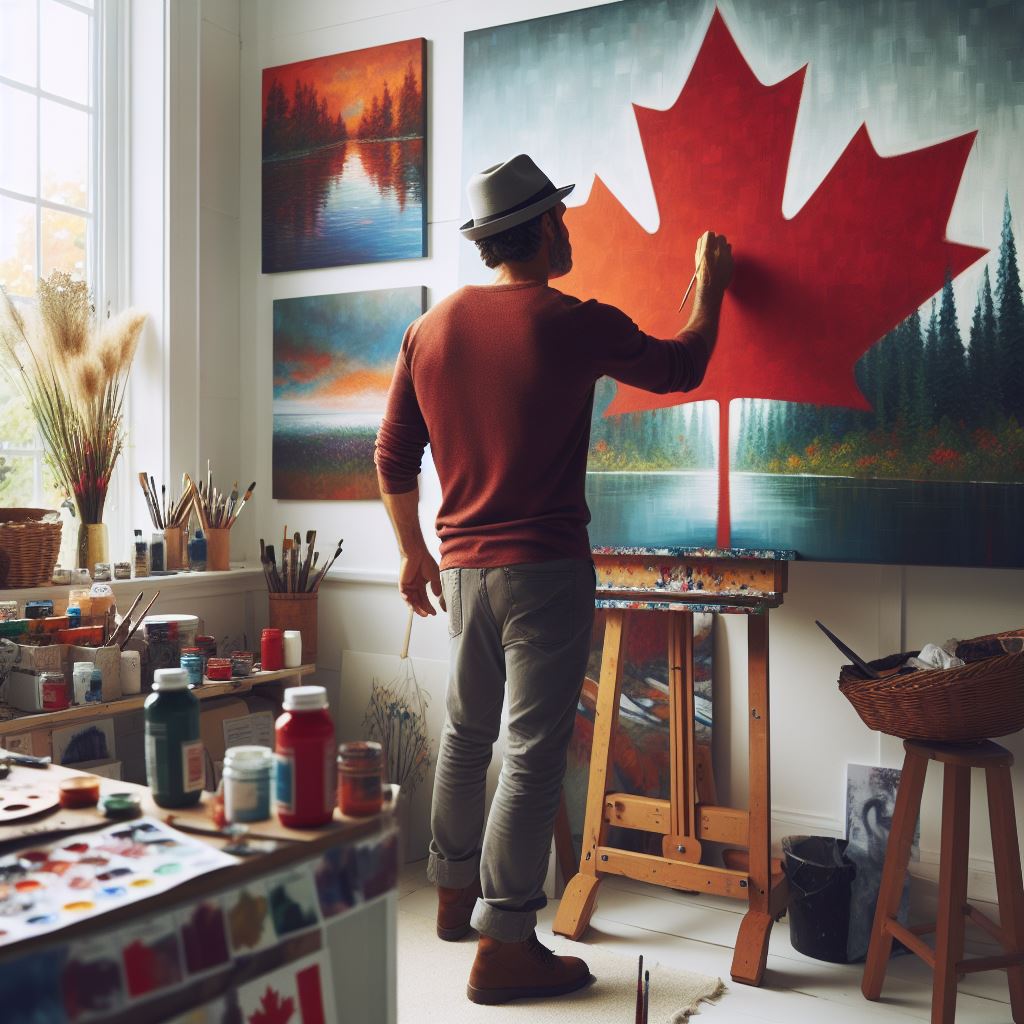The Canadian Artist’s Guide to Gallery Representation
Last Updated on January 22, 2024
Introduction
Let’s explore more about artist gallery representation.
In the dynamic art landscape, gallery representation is crucial for Canadian artists seeking visibility, credibility, and sales.
Embarking on “The Canadian Artist’s Guide to Gallery Representation”:
- Understanding the significance of gallery representation.
- Navigating the intricacies of the Canadian art scene.
- Unlocking opportunities, networking, and establishing fruitful collaborations.
- Mastering the art of approaching and securing gallery representation.
- Maximizing the benefits for artistic growth, exposure, and sustainable success.
This blog post provides a comprehensive guide to empower Canadian artists in navigating and leveraging gallery representation effectively.
Understanding Gallery Representation
Definition and significance of gallery representation
- Gallery representation refers to an agreement between an artist and a gallery to exhibit and sell their artwork.
- It is a crucial partnership that provides artists with professional opportunities to display and promote their work.
- Having gallery representation can elevate an artist’s career and credibility within the art industry.
- It indicates that the artist’s work has been vetted and deemed worthy of exhibition by professionals.
- Gallery representation is a validation of an artist’s talent and can boost their reputation among collectors and peers.
Role of galleries in the art industry
- Galleries serve as intermediaries between artists and art collectors, connecting the two parties.
- They curate and present exhibitions, creating a platform for artists to showcase their work.
- Galleries promote artists through marketing strategies, such as advertisements and online presence.
- They handle the sales process, negotiation of prices, and facilitate transactions with potential buyers.
- Galleries also provide expertise in art market trends and pricing to assist artists in their career development.
Benefits of having gallery representation for Canadian artists
- Increased visibility and exposure: Gallery representation exposes artists to a wider audience, including curators, collectors, and art enthusiasts.
- Networking opportunities: Galleries have established connections within the art world, enabling artists to build professional relationships.
- Professional presentation: Galleries offer curated exhibitions, showcasing an artist’s work in a manner that enhances its value.
- Access to resources: Galleries provide resources such as exhibition space, marketing materials, and promotional efforts.
- Opportunities for growth: Gallery representation can lead to solo exhibitions, group shows, and participation in art fairs.
- Validation and reputation building: Being represented by a reputable gallery adds credibility and prestige to an artist’s career.
- Sales and financial support: Galleries handle the sales process, allowing artists to focus on creating art while earning income through commissions.
- Career guidance: Galleries often offer artists guidance on pricing, portfolio development, and strategic career decisions.
- Long-term partnerships: Gallery representation can lead to long-term relationships with collectors and institutional buyers.
- International recognition: Galleries with international reach can expose Canadian artists to a global art market.
In short, gallery representation plays a significant role in the career of Canadian artists.
It provides opportunities for visibility, networking, professional presentation, and access to resources.
Additionally, it validates an artist’s talent, offers sales support, and fosters long-term partnerships.
Therefore, securing gallery representation can be highly beneficial for Canadian artists looking to thrive in the competitive art industry.
Read: Creating Your Brand as a Canadian Actor
Finding the Right Gallery
Researching and identifying potential galleries
- Consider the advantages of local galleries compared to international galleries.
- Conduct thorough research to assess the reputations and specialties of different galleries.
- Look for galleries that align with the artist’s unique style and artistic vision.
Building connections and relationships with galleries
Research potential galleries, weighing local versus international advantages, considering access and exposure for the artist’s goals.
Conduct thorough gallery research, assessing reputation, past exhibitions, and specialties aligning with the artist’s style.
Align artist style and vision with the gallery’s artistic direction for a mutually beneficial partnership.
Network at gallery openings and art events, establishing connections with representatives, curators, and fellow artists.
Approach gallery owners and curators with genuine interest, fostering relationships based on mutual respect and shared interests.
Develop a strong portfolio showcasing the artist’s best works, leaving a lasting impression on gallery representatives.
Craft an artist statement that articulates inspirations, artistic philosophy, and vision, aiding galleries in understanding the artist’s perspective.
In conclusion, securing gallery representation involves strategic research, networking, alignment of visions, and showcasing a compelling portfolio.
Read:The Future of Acting in Canada: Industry Trends
Preparing Artwork and Documentation
Tips for creating a professional portfolio
- Selecting high-quality images of artwork.
- Organizing the portfolio effectively.
- Including artist biography and CV in the portfolio.
Creating a professional portfolio is essential for artists seeking gallery representation. It is the artist’s visual identity and a crucial marketing tool.
Here are some tips on how to create an impressive portfolio.
- Selecting high-quality images of artwork:
Choose images that accurately represent your style, technique, and artistic vision. High-resolution photographs with proper lighting and minimal distractions are vital. Ensure that the images capture the essence and quality of your artwork. - Organizing the portfolio effectively:
Arrange the artwork in a logical and cohesive manner. Consider the flow and narrative when curating your portfolio. Begin with a strong piece to grab the viewer’s attention, and maintain a balanced mix of different mediums, themes, and sizes throughout the portfolio. - Including artist biography and CV in the portfolio:
Provide a well-written artist biography that highlights your background, artistic journey, and influences. Write a concise and compelling artist’s statement that explains your creative process and artistic intentions. Include a comprehensive CV outlining your education, exhibitions, awards, and relevant experience.
Importance of proper documentation for artwork
- Certificates of authenticity and provenance.
- Detailed inventory and artist statements.
Proper documentation is crucial for establishing the value and authenticity of your artwork.
It provides essential information to collectors, galleries, and potential buyers. Here are two vital aspects of proper documentation:
- Certificates of authenticity and provenance:
Each artwork should have a certificate of authenticity signed by the artist, establishing its originality and verifying its creation.
Provenance documentation tracks the artwork’s ownership history, including previous exhibitions, sales, and any notable collectors or institutions associated with it. - Detailed inventory and artist statements:
Maintain a comprehensive inventory of your artwork, including details such as title, medium, dimensions, creation date, and current location. This inventory aids in managing your artwork, tracking sales, and providing accurate information to galleries and collectors.
Additionally, writing artist statements that elucidate your artistic intent and explain the concepts behind your work adds value and depth to your portfolio.
In fact, preparing artwork and proper documentation are essential steps in securing gallery representation.
A professional portfolio showcasing high-quality images, organized effectively, and complemented by an artist biography and CV is crucial.
Additionally, ensuring proper documentation with certificates of authenticity, provenance, a detailed inventory, and insightful artist statements enhances your artwork’s value and credibility.
Following these guidelines will increase your chances of success in the competitive art world.

Approaching Galleries
Writing a compelling artist submission letter
- Introduction and personalized approach:
A strong opening that grabs the gallery’s attention and shows familiarity with their work. - Highlighting notable achievements and artistic vision:
Showcase awards, exhibitions, and unique style to emphasize the artist’s talent and potential. - Expressing interest in gallery representation:
Clearly state the desire to collaborate, highlighting the benefits for both parties involved.
Follow-up strategies and etiquette
Craft a personalized introduction, addressing the gallery by name and expressing admiration for their recent exhibitions.
Highlight notable achievements, awards, and exhibitions to validate your talent and potential for a successful collaboration.
Clearly articulate your interest in gallery representation, explaining how your art aligns with their vision.
After submission, wait two to three weeks before sending a concise and respectful follow-up email or making a call.
Express gratitude for their time, reiterate your interest, and be open to feedback or additional requests.
Persistently follow up, adjusting your approach while maintaining respect, avoiding pushiness or demands.
Build a rapport by attending gallery events, engaging with staff, and showing genuine interest in their work.
Approaching galleries with a compelling letter and thoughtful follow-up can increase your chances of securing representation.
Remember, patience, persistence, and respectful communication are key to forging successful professional relationships in the art world.
Read: Canadian Child Actors: Navigating the Industry
Negotiating Gallery Contracts
Understanding the elements of a gallery contract
- Commission rates and pricing agreements.
- Duration of agreement and exclusivity clauses.
- Terms and conditions for artwork storage and transportation.
Seeking legal advice and professional guidance during contract negotiations
Artists must protect their rights by consulting legal advisors, who navigate complex contract language, ensuring full protection.
Lawyers offer insights, suggest modifications, and prevent pitfalls.
Understanding copyright, licensing, and reproduction rights is vital.
Legal professionals help artists grasp implications, preserving ownership and control in gallery contracts.
Negotiating contracts with galleries demands scrutiny. Artists review commission rates, ensuring alignment with industry standards.
Clear pricing agreements prevent disputes. Exclusivity clauses impact artistic freedom, requiring assessment before agreement.
Duration in contracts matters. Artists scrutinize renewal or termination provisions.
Exclusivity clauses restricting other gallery engagements require careful consideration.
Artists focus on artwork storage and transportation terms. Contracts clarify gallery responsibilities, ensuring proper insurance and protection.
Responsibility for costs or damages during transportation is defined.
Seeking legal advice is essential. Lawyers review contracts before signing, avoiding potential pitfalls and ensuring enforceability.
Basically, artists armed with knowledge negotiate fair agreements.
Legal guidance protects rights, navigates copyright complexities, and secures mutually beneficial partnerships with galleries.
Read: Acting and Improv: A Canadian Perspective
Building a Successful Gallery Relationship
Maintaining communication and collaboration
Regular updates and sharing new artwork with the gallery is essential for a thriving artist-gallery relationship.
By providing consistent updates, artists keep galleries informed about their latest projects, exhibitions, and creative development.
This open line of communication allows galleries to stay up-to-date with artists’ progress and plan future events accordingly.
Participating in gallery events and exhibitions is another significant aspect of building a successful artist-gallery relationship.
Artists should actively take part in gallery-hosted events, such as artist talks, workshops, and open studios.
These engagements not only enhance the artist’s visibility but also strengthen their bond with the gallery.
It demonstrates their commitment to the partnership while providing opportunities for collectors and art enthusiasts to engage directly with the artist and their work.
Receiving feedback and guidance from the gallery is invaluable for an artist’s growth and development.
Artists must be receptive to constructive criticism and suggestions from the gallery, as they bring a wealth of expertise and industry knowledge.
By embracing this feedback, artists can refine their artistic practice and align their work with the gallery’s curatorial vision, increasing the likelihood of successful representation.
Promoting the artist-gallery partnership
To maximize exposure and attract potential collectors, artists should leverage social media and online platforms.
Maintaining an active online presence is essential in today’s digital age.
Artists should regularly share updates, exhibition announcements, and behind-the-scenes content on social media platforms like Facebook, Instagram, and Twitter.
By actively engaging with followers and showcasing their work online, artists can create a buzz around their partnership with the gallery.
Engaging in joint marketing and advertising initiatives with the gallery is another effective strategy.
By pooling resources and collaborating on promotional campaigns, artists and galleries can amplify their reach and generate greater interest in their work.
This can include joint advertisement placements in art magazines, shared mailers, or jointly-funded online advertising campaigns.
Such cooperative efforts not only benefit the artist’s career but also strengthen the gallery’s reputation and clientele.
Expanding the artist’s network through gallery connections is a valuable advantage of gallery representation.
Galleries have established networks of collectors, curators, and art professionals, which artists can tap into for future opportunities and collaborations.
Artists should actively participate in gallery-led events, like art fairs, where they can connect with potential buyers and industry contacts.
Building relationships within the art community through gallery connections can open doors to exhibitions, residencies, and commissions.
In general, building a successful gallery relationship requires maintaining open communication, actively collaborating, and maximizing promotional efforts.
Artists must keep galleries informed about their progress, participate in gallery events, and embrace feedback.
Additionally, leveraging social media, engaging in joint marketing initiatives, and expanding networks through gallery connections can greatly enhance an artist’s career.
By cultivating a strong artist-gallery partnership, artists can thrive in the competitive art market and achieve long-term success.
Read: Writing in French: Opportunities in Canada
Conclusion
Recap of the key points discussed
Throughout this guide, we have explored the various benefits of gallery representation for Canadian artists.
It is evident that having gallery representation can greatly enhance an artist’s career and provide opportunities for exposure, networking, and financial stability.
We have also discussed the steps involved in pursuing gallery representation, including creating a strong portfolio, researching and approaching suitable galleries, and building relationships with gallery owners and curators.
Emphasizing the importance of gallery representation for Canadian artists
Gallery representation is crucial for Canadian artists as it gives them credibility and validation within the art world.
It allows artists to gain exposure to a wider audience, increase their chances of selling their work, and establish relationships with collectors and art professionals.
Sign-off and call-to-action to pursue gallery representation opportunities
Now that you have a thorough understanding of the benefits and process of gallery representation, it is time to take action.
Start by refining your portfolio, researching suitable galleries, and reaching out to them with a professional approach.
Remember, gallery representation is an essential step towards achieving your artistic goals, and by pursuing it, you are opening doors to new opportunities and potential success.
Good luck on your journey to finding gallery representation, and may your art reach new heights!


